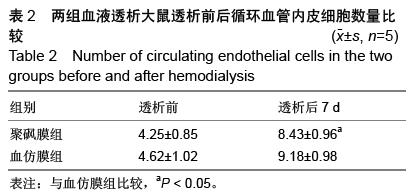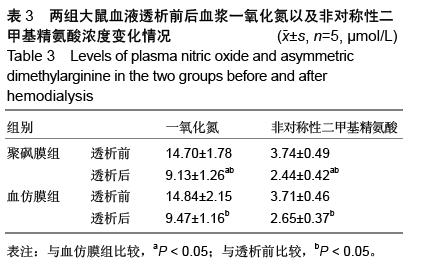| [1] 鄢建军,杜翔,韩敏,等.膜型热循环双重血浆滤过治疗难治性高脂血症的护理[J].护理学杂志:综合版, 2008,23(5): 23-25.
[2] 于颖,孟建中,吕苏一.高分子材料聚砜膜滤器应用于老年急性重症胰腺炎47例[J].中国组织工程研究与临床康复, 2009,13(51):10173-10176.
[3] 黄洪涛,李红梅.不同血液净化方式单次治疗对血液透析患者血清β2-微球蛋白和甲状旁腺激素的影响[J].中华实用诊断与治疗杂志,2009,24(2):171-172.
[4] Xue P, Deng LH, Zhang ZD, et al. Effect of Chaiqinchengqi decoction on sarco/endoplasmic reticulum Ca2+-ATPase mRNA expression of pancreatic tissues in acute pancreatitis rats. World J Gastroenterol. 2008;14(15):2343-2348.
[5] Ardengh JC, Malheiros CA, Rahal F, et al. Microlithiasis of the gallbladder: role of endoscopic ultrasonography in patients with idiopathic acute pancreatitis. Rev Assoc Med Bras. 2010;56(1):27-31.
[6] Manga F, Lim CS, Mangena L,et al. Acute pancreatitis in peritoneal dialysis: a case report with literature review. Eur J Gastroenterol Hepatol. 2012;24(1): 95-101.
[7] 谢逢春,李振华.乌司他丁联合连续性血液滤过对多器官功能障碍综合征患者细胞因子及血管内皮的影响[J].中国中西医结合急救杂志,2009,16(3):182-183.
[8] 马威,王家祥,杨合英,等,短时静-静脉血液滤过在小儿重症急性胰腺炎治疗中的应用[J].中华小儿外科杂志, 2011, 32(3):179 -182.
[9] Cynthia CL, Han KT. An introduction to extracorpo real blood purification in critical illness. Proceed Singapore Healthcare. 2012;21(2):109-119.
[10] Bakker OJ, Van Brunschot S, Van Santvoort HC, et al. Early versus on-demand nasoenteric tube feeding in acute pancreatitis. N Engl J Med. 2014;371(21): 1983-1993.
[11] 郭增革,程博闻,宋俊,等.聚醚砜含量对纤维素/聚醚砜中空纤维血液透析膜结构和性能的影响[J].材料科学与工程学报,2012,30(4):567-570.
[12] Yi Z, Zhu LP, Xu YY, et al. Polysulfone-based amphiphilic polymer for hydrophilicity and fouling-resistant modification of polyethersulfone membranes. J Memb Sci. 2010;365 (1-2): 25-33.
[13] 林晓,肖兆群,蒋挺,等.对重症急性胰腺炎患者合并胰腺感染的危险因素分析[J].当代医药论丛,2014,(13):212-212.
[14] Shen C, Meng Q, Zhang G. Chemical modification of polysulfone membrane by polyethylene glycol for resisting drug adsorption and self assembly of hepatocytes. J Memb Sci. 2011;369(1-2):474-481.
[15] 李红英.血清PCT和CRP对重症急性胰腺炎合并感染的影响[J].中国医学创新,2012,9(19):27-28.
[16] Cai Y, Li J, Guo Y, et al. In-situ monitoring of asymmetric poly (ethylene -co -vinyl alcohol) membrane formation via a phase inversion process by an ultrasonic through-transmission technique. Desalination. 2011;283(1):25-30.
[17] 曹斌,吕德超,王家宝,等.重症急性胰腺炎早期肠功能障碍与继发胰腺感染的关系[J].中国临床保健杂志, 2014,(5): 478-479.
[18] 张卓,王清华,严华姿.终末期肾脏病维持性血液透析患者并发消化道出血危险因素分析[J].中国医刊, 2011,46(5):54-56.
[19] 吴兴茂,吉凯强,汪海源,等.全肠内营养对急性重症胰腺炎的胰腺坏死性感染的预防作用的研究[J].中国现代医学杂志,2013,23(4):101-104.
[20] Yin Z, Su B, Nie S, et al. Poly (vinylpyrrolidone- co-acrylonitrile- covinylpyrrolidone) modified polyethersulfone hollow fiber membranes with improved blood compatibility. Fibers Polymers. 2012;13(3):269-276.
[21] Yamashita AC, Tomisawa N. Importance of membrane materials for blood purification devices in critical care. Transfus Apher Sci. 2009;40(1):23-31.
[22] 杨晶,王海鹏,周莉,等.益生菌在重症急性胰腺炎患者中作用效果的Meta分析[J].中华消化杂志,2012,32(2):93-97.
[23] 杨尽晖,陈晚平,吴金术,等.替考拉宁治疗重症胰腺炎并发肠球菌属感染患者42例报道[J].中华医院感染学杂志, 2010,20(4):557-558.
[24] Barzin J, Madaeni SS, Pourmoghadasi S. Hemodialysis membranes prepared from poly (vinyl alcohol): effects of the preparation conditions on the morphology and performance. J Applied Polymer Sci. 2007;104(4):2490-2497.
[25] Ghaemi N, Madaeni SS, Alizadeh A, et al. Fabrication and modification of polysulfone nanofiltration membrane using organic acids: morphology, characterization and performance in removal of xenobiotics. Sep Purif Technol. 2012;96(31):214-228.
[26] 曹宁.肾功能衰竭患者采用不同血液透析膜材料的生物相容性对比分析[J].中国组织工程研究, 2012,16(25): 4728-4733.
[27] 于黔,赵素云,蒋文勇,等.不同透析膜和不同血液净化方式对血液透析患者炎症递质的影响[J].临床肾脏病杂志, 2011,11(3):116-117.
[28] 天津生,张怡静.不同透析膜对血透患者血清C反应蛋白、白细胞介素6、白细胞介素七和白蛋白的影响[J].临床内科杂志,2012,29(1):40-42.
[29] Ferraz N, Stromme M, Fellstrom B, et al. In vitro and in vivo toxicity of rinsed and aged nanocellulose -polypyrrole composites. J Biomed Mater Res Part A. 2012;100A(8):2128-2138.
[30] Yi Z, Zhu LP, Zhao YF, et al. An extending of candidate for the hydrophilic modification of polysulfone membranes from the compatibility consideration: the polyethersulfone-based amphiphilic copolymer as an example. J Memb Sci. 2012;390-391(10):48-57.
[31] 石磊.不同透析膜材料在维持性血液透析过程中的生物相容性[J].中国组织工程研究与临床康复, 2010,14(34): 6453-6456.
[32] Krieter DH, Morgenroth A, Barasinski A, et al. Effects of a polyelectrolyte additive on the selective dialysis membrane permeability for low-MW proteins. Nephrol Dial Transplant. 2007;22(2):491-499.
[33] Barzin J, Feng C, Khulbe KC, et al. Characterization of polyethersulfone hemodialysis membrane by ultrafiltration and atomic force microsopy. J Memb Sci. 2004;237:77-85.
[34] 董婷,李静,杨文明,等.补中益气汤治疗重症肌无力临床研究[J].中国中医急症,2011,20(2):212-213,236.
[35] 鄢建军,杜翔,韩敏,等.膜型热循环双重血浆滤过治疗难治性高脂血症的护理[J].护理学杂志:综合版,2008,23(5): 23-25.
[36] 谢志明,谢佳琳,韩静,等.聚砜膜滤器无肝素抗凝 CBP在治疗消化道出血MODS患者中的应用[J].医疗器械, 2007, 4(30):162-163.
[37] 冯德辉.血液透析膜材料在重症胰腺炎领域的应用[J].中国组织工程研究与临床康复,2011,15(29):5417-5420.
[38] Pongprasobchai S, Jianjaroonwong V, Charatcharoenwitthaya P, et al. Erythrocyte sedimentation rate and C-reactive protein for the prediction of severity of acute pancreatitis. Pancreas. 2010;39(8):1226-1230.
[39] Duarte-Rojo A, Sosa-Lozano LA, Saúl A, et al. Methods for measuring abdominal obesity in the prediction of severe acute pancreatitis, and their correlation with abdominal fat areas assessed by computed tomography. Aliment Pharmacol Ther. 2010; 32(2):244-253.
[40] 樊景云,徐建玉,唐毅,等.Ranson和APACHEⅡ评分对重症急性胰腺炎患者死亡风险的评估价值[J].胃肠病学和肝病学杂志,2010,19(1):81-83. |
.jpg)


